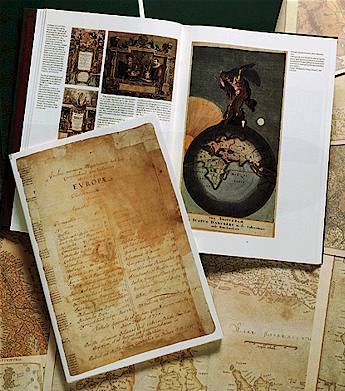Accompanying the portfolio of map facsimiles, the
large-format and richly illustrated
book contains essays by an international group of
distinguished map scholars. The
contributors to The Mercator Atlas of Europe
leave no aspect of the fascinating history of
this atlas unexamined. The essays:
"The Atlas of Europe, circa 1550-1572" by
Marcel Watelet
A review of the atlas's provenance - from Mercator's cutting
and pasting together copies of his wall maps to a bookshop
in Belgium to the British Library, its current home. |
| |
"Atlas, Birth of a Title" by
James R. Akerman
While Mercator is credited with coining the name atlas to
refer to maps bound between boards, he did not invent the
atlas concept. Mercator made his first real atlas in 1585.
Here we learn more about the Atlas mythology and Mercator's
choice of the name. |
| |
"The Map of Europe" by
Arthur Dürst
The celebrated 1554 map of Europe represented a major
cartographic achievement, and for the next two centuries it
became the accepted picture of the continent, signifying the
beginning of a new geography. |
| |
"The British Isles" by
Peter M. Barber
The deputy map librarian at the British Library provides a
scholarly discussion of the sources of Mercator's map of the
British Isles—ultimately a story of intrigue and
deception at the hands of a Scottish traitor intent on
aiding a Catholic invasion against Tudor England and
Elizabeth I.
Mercator credits a "friend" with creating his
1564 map of the British Isles. Who was this mysterious mapmaker?
Read this fascinating excerpt
from Peter Barber's chapter, as seen in the July/August 1998
issue of
Mercator's World®magazine.
|
| |
"The 1569 Word Map" by
Mireille Pastoureau
Mercator is best-known to us today for this cylindrical world
map projection, which enabled navigators to plot a long
course in straight lines. One of the most revolutionary
inventions in the history of cartography, Mercator's
projection has greatly influenced our image of the world. |
